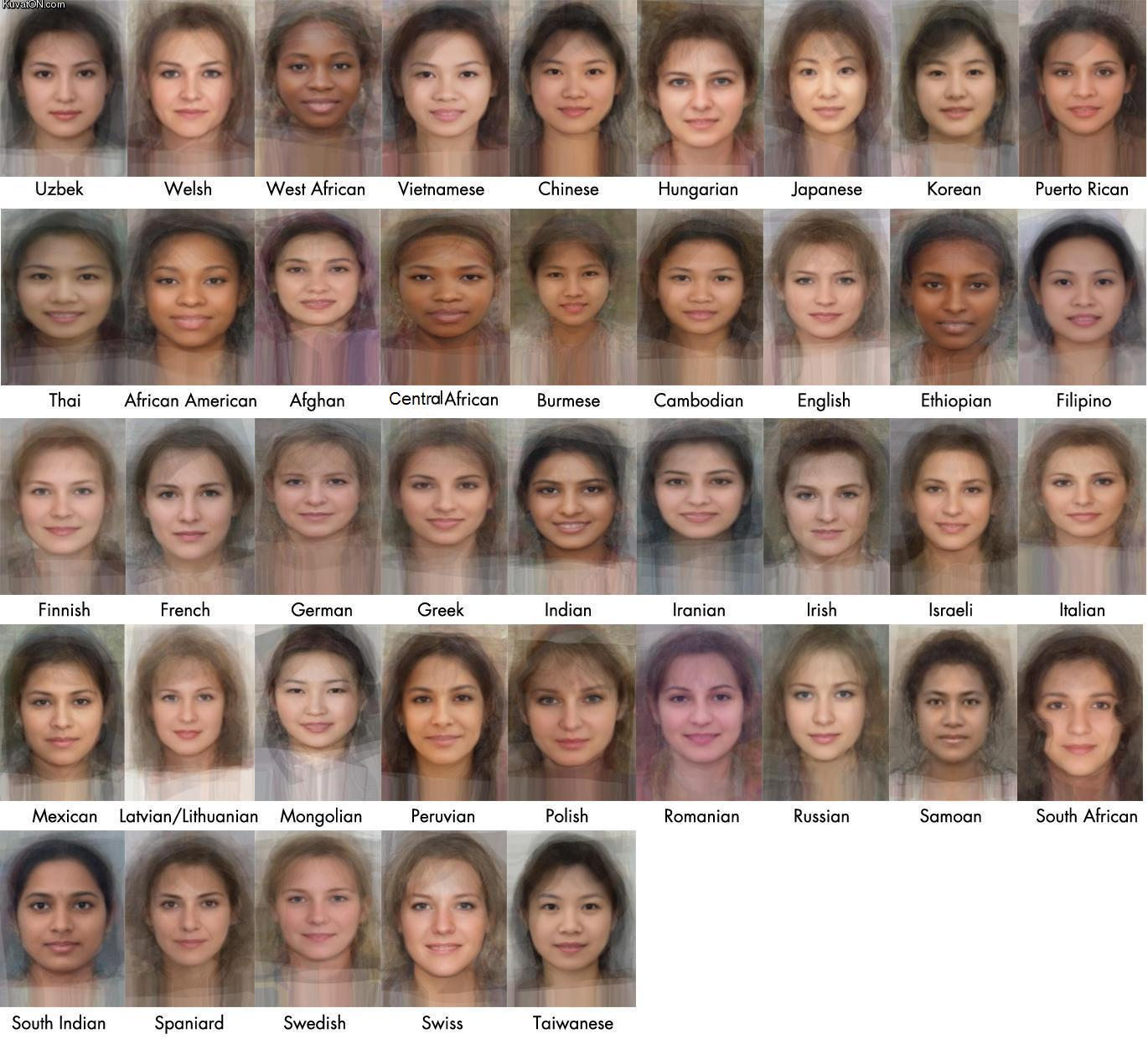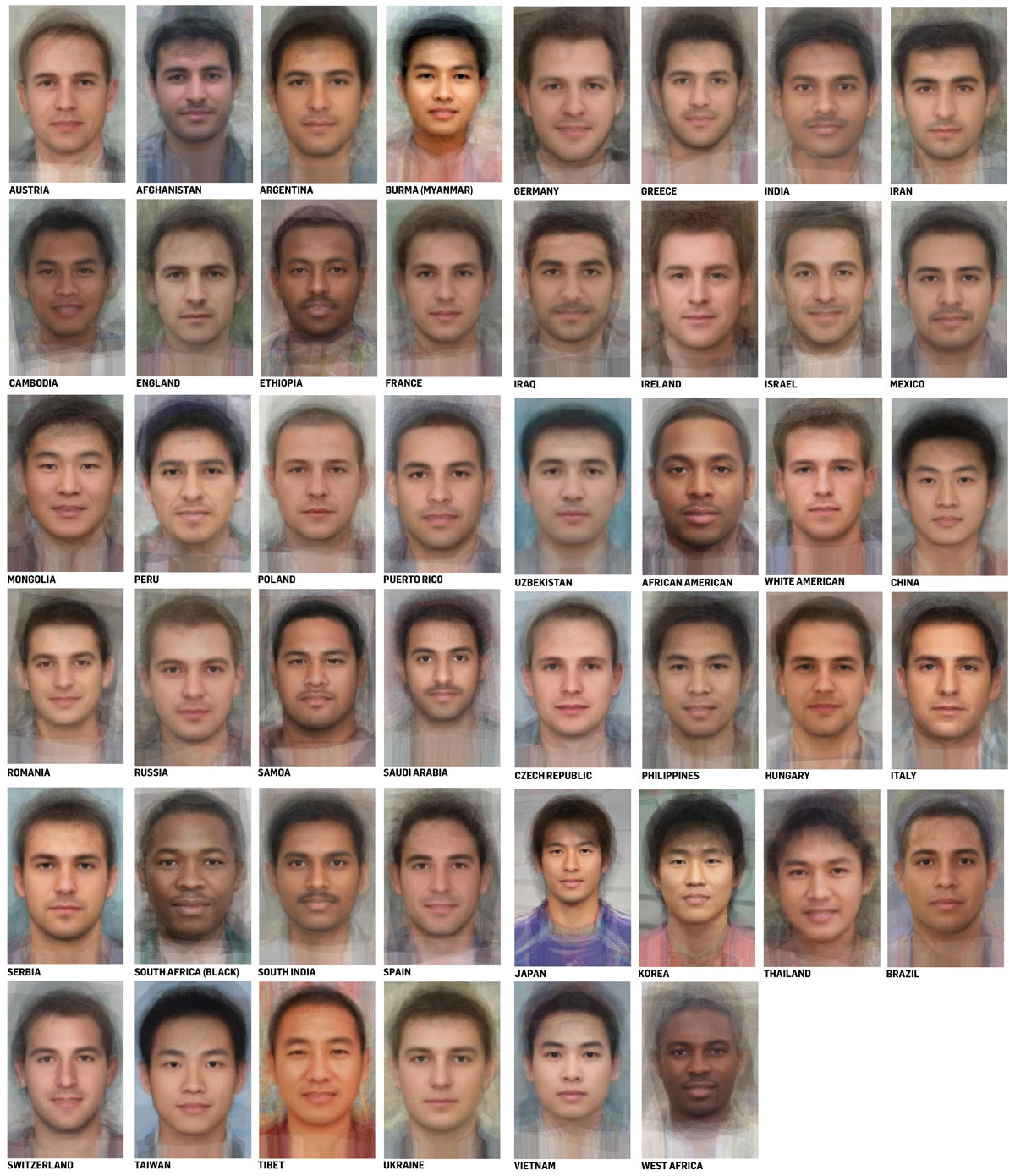It looks like you're using an Ad Blocker.
Please white-list or disable AboveTopSecret.com in your ad-blocking tool.
Thank you.
Some features of ATS will be disabled while you continue to use an ad-blocker.
3
share:
To start, I used the search function and didn't see this anywhere and mods if this is in the wrong forum please feel free to move it to the
appropriate one.
I was doing some research and came across an article on Discovery News called Faces Of Our Ancestors which was very intriguing to me. It got me thinking about what future generations would discover about us and what they would think we looked like? Then I came across the work of Mike Mike from South Africa;
The Face of Tomorrow
Female Faces By Country;

Male Faces By Country;

Link to the faces used to create each face by country above
Source
I was doing some research and came across an article on Discovery News called Faces Of Our Ancestors which was very intriguing to me. It got me thinking about what future generations would discover about us and what they would think we looked like? Then I came across the work of Mike Mike from South Africa;
The Face of Tomorrow
The Face of Tomorrow is a new series of works by Istanbul based photographer Mike Mike. It deals with notions of race, place, identity and belonging on both an extremely local level as well as on an impossibly ambitious, almost Borgesian, global scale. The project is an exploration of human identity as affected by the forces of globalization and makes full use of all the tools of the modern economy – distributed work across several time zones, outsourcing to take advantages of cost disparities, an open source model that allows input from contributors, and of course the internet itself as a medium of display and exchange. Mike travels the world photographing in each city the first one hundred people he can convince to take part in his project. He then combines the faces to create one new male and female individual, which for him is a distilled representation of that place at a future moment in time. On a personal level it is one artist’s search for identity and belonging and the relationship of self to the larger world. On a deeper level it as an exploration of the systems behind globalization and how these systems might influence the future make-up of each individual locus. Having grown up in apartheid-era South Africa, educated on four continents and currently living in Istanbul, itself a “schizophrenic city” sited on two continents looking east and west as well as north and south, it is understandable that these issues arising from globalization would form the central thesis of his work. The project has now taken on a life of its own, like a computer code or virus, and at present there are people in Colombia, Japan, Germany and Holland working on the project independently of Mike.
Mike’s journey of discovery began a few years ago, on a trip to London. “Sitting on the underground train, I was intrigued by the sheer diversity of the place – Somalis, Indians, Americans, Zimbabweans, Scandinavians and a hundred other nationalities vying for their place in the metropolis. I thought “what is this place, what is a Londoner?” A few weeks later I was in Istanbul and looking at the relative uniformity of the population I realized I was looking at the future of London. A thousand years ago Istanbul was the capital of the remnants of the Roman Empire – home to an astonishing variety of peoples from Greece, Rome, central Asia, Arabia and the Russia. Yet now this diversity had coalesced around a mean – almost everyone dark haired, brown-eyed and olive-skinned. And I thought if one could merge all the people in a place like London one would be looking at the future of that place – one would have some notion of what a Londoner is or will become.”
Taking as his reference point the early work of Francis Galton and more recent works by Gerhard Lang and Nancy Burson, which explore issues of identity through a layering photographic technique, Mike has established a systematic almost census-like approach to this theme. Asking the question “What does a New Yorker, a Londoner, a Parisian look like?” he attempts to find an answer by photographing one hundred people he stops at random on the street and then combining those faces to create a new individual – someone that doesn’t exist right now but someone it seems quite real – almost familiar.
The Face of Tomorrow is intensely site-specific as we meet individuals from different locales around the globe and it is also extremely broad in its scope as it attempts to distil these individuals into one face that somehow captures the “look” of a city or place. "The process of merging the faces and coming up with someone new is really exciting. Archetypal creative stuff. You end up with a new person. Someone who didn't exist before. Someone who doesn't exist now. But someone who is nonetheless quite real." The work is thus at the same time a document of a place at a moment in time and also an extrapolation of that place towards some utopian future where all differences of race or individuality are forgotten. It is this juxtaposition between the real and the unreal, between the foreign and the familiar, between the ordinary and the extraordinary and between the photographic and the painterly that allows the work to resonate beyond its immediate spatial and temporal references. It allows connections to be made despite these limitations as we see that different places around the world can sometimes produce dramatically similar results. These disjunctions allow viewers to question their own notion of self and identity and to perhaps come away challenged on one level and appreciative of an underlying connectedness between all humanity on another.
Female Faces By Country;

Male Faces By Country;

Link to the faces used to create each face by country above
Source
That was really interesting! We've seen images of what man might have looked like in the past, but it was really cool seeing images of what we may
look like in the future. I saw the future face of my ancestral homeland, and it jumped out at me before I even saw the country. Thanks for posting
that.
Lol, what happened to American Indian?
Didn't American Indian tribes help win WW2?
Didn't American Indian tribes help win WW2?
reply to post by JWash
I noticed that as well and there are a few nationalities/places that are missing as well,so the project isn't complete even though it does cover a significant portion of the global population. However with that being said the project isn't completed and Mike Mike has openly addressed this;
It's actually something I was considering doing..I think it would be interesting, fun and not a bad way to meet new people.
I noticed that as well and there are a few nationalities/places that are missing as well,so the project isn't complete even though it does cover a significant portion of the global population. However with that being said the project isn't completed and Mike Mike has openly addressed this;
The Face of Tomorrow is an open source project. Anyone can send in 100 photos and Mike will composite the face for that city or place. All you need is a digital camera and a tripod. It takes a couple of hours and it’s a lot of fun. Take a look at The Source Code to see how this works in practice.
In each city I take 100 photos of people in one specific location. I then divide these into male and female and from these I make a composite face. I am not interested in whether a person was born in that place, whether they are a citizen or whether they are simply a tourist. Everyone who is in that place represents the future potential face of that place. In this way the Face of Tomorrow is like a census. A snapshot of a place at a moment in time. The present and the future.
It's actually something I was considering doing..I think it would be interesting, fun and not a bad way to meet new people.
Originally posted by JWash
Lol, what happened to American Indian?
Didn't American Indian tribes help win WW2?
Uh... Did they??
new topics
-
Watts home paranormal activity
Paranormal Studies: 3 hours ago -
So, what is really going on in South Korea ?
World War Three: 3 hours ago -
Congress Says the FBI is Covering Up Vital Info on the Jan 5th 2021 D.C. Pipe Bombs at RNC-DNC.
Political Conspiracies: 4 hours ago -
The trial on kids was stopped
Medical Issues & Conspiracies: 6 hours ago -
Orbs Appear And Form Triangle On Live Cam.
Aliens and UFOs: 8 hours ago -
Biden Has New Bizarre Injuries to His Face
Politicians & People: 10 hours ago -
Something is not adding up in regards to the H-1B commotion
General Conspiracies: 10 hours ago -
Elon Musk Calls for Tommy Robinson to be Freed - and Takes a Dig at Starmer
Politicians & People: 11 hours ago -
Biden to award Presidential Citizens Medal to Liz Cheney and Bennie Thompson
US Political Madness: 11 hours ago
top topics
-
Biden to award Presidential Citizens Medal to Liz Cheney and Bennie Thompson
US Political Madness: 11 hours ago, 11 flags -
Biden Has New Bizarre Injuries to His Face
Politicians & People: 10 hours ago, 11 flags -
Congress Says the FBI is Covering Up Vital Info on the Jan 5th 2021 D.C. Pipe Bombs at RNC-DNC.
Political Conspiracies: 4 hours ago, 9 flags -
The trial on kids was stopped
Medical Issues & Conspiracies: 6 hours ago, 9 flags -
Just learned a really helpful trick for internet searches
Computer Help: 17 hours ago, 7 flags -
Orbs Appear And Form Triangle On Live Cam.
Aliens and UFOs: 8 hours ago, 6 flags -
Something is not adding up in regards to the H-1B commotion
General Conspiracies: 10 hours ago, 5 flags -
Elon Musk Calls for Tommy Robinson to be Freed - and Takes a Dig at Starmer
Politicians & People: 11 hours ago, 5 flags -
So, what is really going on in South Korea ?
World War Three: 3 hours ago, 5 flags -
Watts home paranormal activity
Paranormal Studies: 3 hours ago, 3 flags
active topics
-
Tesla Cybertruck Explodes in Front of Trump Hotel in Las Vegas
Mainstream News • 134 • : FlatBatt -
Congress Says the FBI is Covering Up Vital Info on the Jan 5th 2021 D.C. Pipe Bombs at RNC-DNC.
Political Conspiracies • 19 • : WeMustCare -
Biden to award Presidential Citizens Medal to Liz Cheney and Bennie Thompson
US Political Madness • 14 • : WeMustCare -
So, what is really going on in South Korea ?
World War Three • 6 • : CriticalStinker -
-@TH3WH17ERABB17- -Q- ---TIME TO SHOW THE WORLD--- -Part- --44--
Dissecting Disinformation • 3903 • : duncanagain -
The C.D.C. Says There Was NO INFLUENZA Worth Reporting for the 2020-2021 Flu Season.
Diseases and Pandemics • 98 • : WeMustCare -
Strange fog all over the northern hemisphere
General Conspiracies • 45 • : TheMisguidedAngel -
The trial on kids was stopped
Medical Issues & Conspiracies • 8 • : fos613 -
Mood Music Part VI
Music • 3775 • : Skinnerbot -
Something is not adding up in regards to the H-1B commotion
General Conspiracies • 27 • : fringeofthefringe
3
